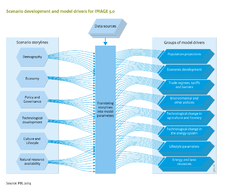Drivers/Scenario drivers: Difference between revisions
< Drivers
Jump to navigation
Jump to search
m (Text replace - "Nutrient balances" to "Nutrients") |
No edit summary |
||
| Line 3: | Line 3: | ||
|Sequence=2 | |Sequence=2 | ||
|Reference=PBL, 2010; PBL, 2011; OECD, 2008; Moss et al., 2010; IIASA, 2013; UN, 2013; Lutz and KC, 2010; Van Vuuren et al., 2007b; | |Reference=PBL, 2010; PBL, 2011; OECD, 2008; Moss et al., 2010; IIASA, 2013; UN, 2013; Lutz and KC, 2010; Van Vuuren et al., 2007b; | ||
|Description= | |Description=<h2>Scenario drivers</h2> | ||
<h2>Scenario drivers</h2> | |||
On the basis of how the world may develop in the longer term, the following six key scenario drivers are distinguished: demography, economy, culture and lifestyle, natural resource availability, technological development, and policy and governance, see flowchart. The future direction of these drivers is often inferred from the storyline or narrative, which may range from brief to very detailed. The storyline describes the following scenario types and functions: | On the basis of how the world may develop in the longer term, the following six key scenario drivers are distinguished: demography, economy, culture and lifestyle, natural resource availability, technological development, and policy and governance, see flowchart. The future direction of these drivers is often inferred from the storyline or narrative, which may range from brief to very detailed. The storyline describes the following scenario types and functions: | ||
*reference projection with no new policies ([[OECD, 2008]]); | *reference projection with no new policies ([[OECD, 2008]]); | ||
Revision as of 08:21, 24 May 2014
Parts of Drivers/Scenario drivers
| Projects/Applications |
| Models/Databases |
| Relevant overviews |
| Key publications |
| References |
